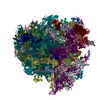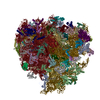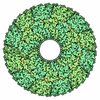+ Open data
Open data
- Basic information
Basic information
| Entry | Database: PDB / ID: 9bdn | ||||||
|---|---|---|---|---|---|---|---|
| Title | 80S ribosome with angiogenin and tRNAAla | ||||||
 Components Components |
| ||||||
 Keywords Keywords | RIBOSOME / Angiogenin / RNase | ||||||
| Function / homology |  Function and homology information Function and homology informationangiogenin-PRI complex / negative regulation of translation in response to stress / tRNA-specific ribonuclease activity / tRNA-derived small RNA (tsRNA or tRNA-related fragment, tRF) biogenesis / tRNA decay / signaling / cell communication / Hydrolases; Acting on ester bonds; Endoribonucleases producing 3'-phosphomonoesters / ribosomal subunit / Adherens junctions interactions ...angiogenin-PRI complex / negative regulation of translation in response to stress / tRNA-specific ribonuclease activity / tRNA-derived small RNA (tsRNA or tRNA-related fragment, tRF) biogenesis / tRNA decay / signaling / cell communication / Hydrolases; Acting on ester bonds; Endoribonucleases producing 3'-phosphomonoesters / ribosomal subunit / Adherens junctions interactions / oocyte maturation / homeostatic process / hematopoietic stem cell proliferation / rRNA transcription / basement membrane / positive regulation of phosphorylation / ubiquitin ligase inhibitor activity / positive regulation of signal transduction by p53 class mediator / endocytic vesicle / RNA nuclease activity / 90S preribosome / phagocytic cup / protein-RNA complex assembly / ovarian follicle development / rough endoplasmic reticulum / response to hormone / translation regulator activity / ribosomal small subunit export from nucleus / gastrulation / positive regulation of endothelial cell proliferation / actin filament polymerization / MDM2/MDM4 family protein binding / peptide binding / cytosolic ribosome / class I DNA-(apurinic or apyrimidinic site) endonuclease activity / RNA endonuclease activity / DNA-(apurinic or apyrimidinic site) lyase / stress granule assembly / placenta development / ribosomal large subunit biogenesis / maturation of LSU-rRNA from tricistronic rRNA transcript (SSU-rRNA, 5.8S rRNA, LSU-rRNA) / positive regulation of apoptotic signaling pathway / maturation of SSU-rRNA from tricistronic rRNA transcript (SSU-rRNA, 5.8S rRNA, LSU-rRNA) / positive regulation of protein secretion / maturation of SSU-rRNA / small-subunit processome / negative regulation of smooth muscle cell proliferation / spindle / cytoplasmic ribonucleoprotein granule / cytoplasmic stress granule / rRNA processing / antimicrobial humoral immune response mediated by antimicrobial peptide / antibacterial humoral response / rhythmic process / positive regulation of canonical Wnt signaling pathway / cell migration / heparin binding / regulation of translation / actin cytoskeleton / large ribosomal subunit / chromosome / ribosome binding / growth cone / actin binding / ribosomal small subunit biogenesis / ribosomal small subunit assembly / 5S rRNA binding / small ribosomal subunit / ribosomal large subunit assembly / small ribosomal subunit rRNA binding / large ribosomal subunit rRNA binding / cytosolic small ribosomal subunit / endonuclease activity / angiogenesis / defense response to Gram-negative bacterium / perikaryon / killing of cells of another organism / cytosolic large ribosomal subunit / cytoplasmic translation / cell differentiation / tRNA binding / response to hypoxia / negative regulation of translation / mitochondrial inner membrane / defense response to Gram-positive bacterium / postsynaptic density / rRNA binding / structural constituent of ribosome / ribosome / translation / receptor ligand activity / ribonucleoprotein complex / copper ion binding / signaling receptor binding / innate immune response / cell division / DNA repair / neuronal cell body / mRNA binding / apoptotic process Similarity search - Function | ||||||
| Biological species |  Homo sapiens (human) Homo sapiens (human)   | ||||||
| Method | ELECTRON MICROSCOPY / single particle reconstruction / cryo EM / Resolution: 3.1 Å | ||||||
 Authors Authors | Loveland, A.B. / Korostelev, A.A. | ||||||
| Funding support |  United States, 1items United States, 1items
| ||||||
 Citation Citation |  Journal: Nature / Year: 2024 Journal: Nature / Year: 2024Title: Structural mechanism of angiogenin activation by the ribosome. Authors: Anna B Loveland / Cha San Koh / Robin Ganesan / Allan Jacobson / Andrei A Korostelev /  Abstract: Angiogenin, an RNase-A-family protein, promotes angiogenesis and has been implicated in cancer, neurodegenerative diseases and epigenetic inheritance. After activation during cellular stress, ...Angiogenin, an RNase-A-family protein, promotes angiogenesis and has been implicated in cancer, neurodegenerative diseases and epigenetic inheritance. After activation during cellular stress, angiogenin cleaves tRNAs at the anticodon loop, resulting in translation repression. However, the catalytic activity of isolated angiogenin is very low, and the mechanisms of the enzyme activation and tRNA specificity have remained a puzzle. Here we identify these mechanisms using biochemical assays and cryogenic electron microscopy (cryo-EM). Our study reveals that the cytosolic ribosome is the activator of angiogenin. A cryo-EM structure features angiogenin bound in the A site of the 80S ribosome. The C-terminal tail of angiogenin is rearranged by interactions with the ribosome to activate the RNase catalytic centre, making the enzyme several orders of magnitude more efficient in tRNA cleavage. Additional 80S-angiogenin structures capture how tRNA substrate is directed by the ribosome into angiogenin's active site, demonstrating that the ribosome acts as the specificity factor. Our findings therefore suggest that angiogenin is activated by ribosomes with a vacant A site, the abundance of which increases during cellular stress. These results may facilitate the development of therapeutics to treat cancer and neurodegenerative diseases. | ||||||
| History |
|
- Structure visualization
Structure visualization
| Structure viewer | Molecule:  Molmil Molmil Jmol/JSmol Jmol/JSmol |
|---|
- Downloads & links
Downloads & links
- Download
Download
| PDBx/mmCIF format |  9bdn.cif.gz 9bdn.cif.gz | 4.8 MB | Display |  PDBx/mmCIF format PDBx/mmCIF format |
|---|---|---|---|---|
| PDB format |  pdb9bdn.ent.gz pdb9bdn.ent.gz | Display |  PDB format PDB format | |
| PDBx/mmJSON format |  9bdn.json.gz 9bdn.json.gz | Tree view |  PDBx/mmJSON format PDBx/mmJSON format | |
| Others |  Other downloads Other downloads |
-Validation report
| Summary document |  9bdn_validation.pdf.gz 9bdn_validation.pdf.gz | 1.7 MB | Display |  wwPDB validaton report wwPDB validaton report |
|---|---|---|---|---|
| Full document |  9bdn_full_validation.pdf.gz 9bdn_full_validation.pdf.gz | 1.8 MB | Display | |
| Data in XML |  9bdn_validation.xml.gz 9bdn_validation.xml.gz | 334.8 KB | Display | |
| Data in CIF |  9bdn_validation.cif.gz 9bdn_validation.cif.gz | 596.7 KB | Display | |
| Arichive directory |  https://data.pdbj.org/pub/pdb/validation_reports/bd/9bdn https://data.pdbj.org/pub/pdb/validation_reports/bd/9bdn ftp://data.pdbj.org/pub/pdb/validation_reports/bd/9bdn ftp://data.pdbj.org/pub/pdb/validation_reports/bd/9bdn | HTTPS FTP |
-Related structure data
| Related structure data |  44463MC  9bdlC  9bdpC M: map data used to model this data C: citing same article ( |
|---|---|
| Similar structure data | Similarity search - Function & homology  F&H Search F&H Search |
- Links
Links
- Assembly
Assembly
| Deposited unit | 
|
|---|---|
| 1 |
|
- Components
Components
-RNA chain , 7 types, 8 molecules A18SA28SA58SA5SETRNPTRNMRNATIRN
| #1: RNA chain | Mass: 602777.875 Da / Num. of mol.: 1 / Source method: isolated from a natural source / Source: (natural)  | ||||
|---|---|---|---|---|---|
| #2: RNA chain | Mass: 1166972.250 Da / Num. of mol.: 1 / Source method: isolated from a natural source / Source: (natural)  | ||||
| #3: RNA chain | Mass: 50143.648 Da / Num. of mol.: 1 / Source method: isolated from a natural source / Source: (natural)  | ||||
| #4: RNA chain | Mass: 38691.914 Da / Num. of mol.: 1 / Source method: isolated from a natural source / Source: (natural)  | ||||
| #82: RNA chain | Mass: 24802.785 Da / Num. of mol.: 2 / Source method: isolated from a natural source / Source: (natural)  #83: RNA chain | | Mass: 8591.155 Da / Num. of mol.: 1 / Source method: obtained synthetically / Source: (synth.)  Homo sapiens (human) Homo sapiens (human)#84: RNA chain | | Mass: 24486.477 Da / Num. of mol.: 1 / Source method: obtained synthetically Details: in vitro transcribed yeast tRNAAla with non-templated CCA added Source: (synth.)  |
+60S ribosomal protein ... , 28 types, 28 molecules AL02AL03AL04AL05AL06AL07AL09AL11AL14AL15AL17AL19AL20AL21AL23AL26AL27AL28AL30AL31AL33AL34AL35AL36AL37AL39AL43ALNW
-Large ribosomal subunit protein ... , 10 types, 10 molecules AL08AL13AL16AL18AL22AL25AL29AL32AL38AL40
| #11: Protein | Mass: 27351.377 Da / Num. of mol.: 1 / Source method: isolated from a natural source / Source: (natural)  |
|---|---|
| #16: Protein | Mass: 24200.525 Da / Num. of mol.: 1 / Source method: isolated from a natural source / Source: (natural)  |
| #19: Protein | Mass: 23144.859 Da / Num. of mol.: 1 / Source method: isolated from a natural source / Source: (natural)  |
| #21: Protein | Mass: 21568.492 Da / Num. of mol.: 1 / Source method: isolated from a natural source / Source: (natural)  |
| #25: Protein | Mass: 11495.275 Da / Num. of mol.: 1 / Source method: isolated from a natural source / Source: (natural)  |
| #28: Protein | Mass: 13727.181 Da / Num. of mol.: 1 / Source method: isolated from a natural source / Source: (natural)  |
| #32: Protein | Mass: 26708.707 Da / Num. of mol.: 1 / Source method: isolated from a natural source / Source: (natural)  |
| #35: Protein | Mass: 15022.021 Da / Num. of mol.: 1 / Source method: isolated from a natural source / Source: (natural)  |
| #41: Protein | Mass: 8107.752 Da / Num. of mol.: 1 / Source method: isolated from a natural source / Source: (natural)  |
| #43: Protein | Mass: 6199.574 Da / Num. of mol.: 1 / Source method: isolated from a natural source / Source: (natural)  |
-Ribosomal protein ... , 3 types, 3 molecules AL10AL24AS05
| #13: Protein | Mass: 24511.861 Da / Num. of mol.: 1 / Source method: isolated from a natural source / Source: (natural)  |
|---|---|
| #27: Protein | Mass: 14131.536 Da / Num. of mol.: 1 / Source method: isolated from a natural source / Source: (natural)  |
| #56: Protein | Mass: 21525.941 Da / Num. of mol.: 1 / Source method: isolated from a natural source / Source: (natural)  |
-Protein , 8 types, 8 molecules AL12AL42ALP0ANGARACAS00AS21AS26
| #15: Protein | Mass: 16561.117 Da / Num. of mol.: 1 / Source method: isolated from a natural source / Source: (natural)  |
|---|---|
| #45: Protein | Mass: 12198.603 Da / Num. of mol.: 1 / Source method: isolated from a natural source / Source: (natural)  |
| #48: Protein | Mass: 21521.062 Da / Num. of mol.: 1 / Source method: isolated from a natural source / Source: (natural)  |
| #49: Protein | Mass: 16576.117 Da / Num. of mol.: 1 Source method: isolated from a genetically manipulated source Source: (gene. exp.)  Homo sapiens (human) / Gene: ANG, RNASE5 / Production host: Homo sapiens (human) / Gene: ANG, RNASE5 / Production host:  References: UniProt: P03950, Hydrolases; Acting on ester bonds; Endoribonucleases producing 3'-phosphomonoesters |
| #50: Protein | Mass: 34669.113 Da / Num. of mol.: 1 / Source method: isolated from a natural source / Source: (natural)  |
| #51: Protein | Mass: 24361.861 Da / Num. of mol.: 1 / Source method: isolated from a natural source / Source: (natural)  |
| #72: Protein | Mass: 9124.389 Da / Num. of mol.: 1 / Source method: isolated from a natural source / Source: (natural)  |
| #77: Protein | Mass: 11645.794 Da / Num. of mol.: 1 / Source method: isolated from a natural source / Source: (natural)  |
-Protein/peptide , 1 types, 1 molecules AL41
| #44: Protein/peptide | Mass: 3473.451 Da / Num. of mol.: 1 / Source method: isolated from a natural source / Source: (natural)  |
|---|
+40S ribosomal protein ... , 23 types, 23 molecules AS01AS02AS03AS04AS06AS08AS09AS10AS11AS12AS13AS15AS17AS18AS20AS22AS23AS24AS25AS27AS28AS29AS30
-Small ribosomal subunit protein ... , 4 types, 4 molecules AS07AS14AS16AS19
| #58: Protein | Mass: 21629.309 Da / Num. of mol.: 1 / Source method: isolated from a natural source / Source: (natural)  |
|---|---|
| #65: Protein | Mass: 14431.500 Da / Num. of mol.: 1 / Source method: isolated from a natural source / Source: (natural)  |
| #67: Protein | Mass: 16032.804 Da / Num. of mol.: 1 / Source method: isolated from a natural source / Source: (natural)  |
| #70: Protein | Mass: 15611.003 Da / Num. of mol.: 1 / Source method: isolated from a natural source / Source: (natural)  |
-Details
| Has protein modification | Y |
|---|
-Experimental details
-Experiment
| Experiment | Method: ELECTRON MICROSCOPY |
|---|---|
| EM experiment | Aggregation state: PARTICLE / 3D reconstruction method: single particle reconstruction |
- Sample preparation
Sample preparation
| Component | Name: 80S ribosome with angiogenin and tRNAAla / Type: RIBOSOME / Entity ID: all / Source: MULTIPLE SOURCES |
|---|---|
| Molecular weight | Value: 4.5 MDa / Experimental value: NO |
| Buffer solution | pH: 7 |
| Specimen | Embedding applied: NO / Shadowing applied: NO / Staining applied: NO / Vitrification applied: YES |
| Specimen support | Grid type: Quantifoil R2/1 |
| Vitrification | Instrument: FEI VITROBOT MARK IV / Cryogen name: ETHANE / Humidity: 95 % / Chamber temperature: 278 K |
- Electron microscopy imaging
Electron microscopy imaging
| Experimental equipment |  Model: Talos Arctica / Image courtesy: FEI Company |
|---|---|
| Microscopy | Model: FEI TALOS ARCTICA |
| Electron gun | Electron source:  FIELD EMISSION GUN / Accelerating voltage: 200 kV / Illumination mode: FLOOD BEAM FIELD EMISSION GUN / Accelerating voltage: 200 kV / Illumination mode: FLOOD BEAM |
| Electron lens | Mode: BRIGHT FIELD / Nominal defocus max: 1500 nm / Nominal defocus min: 500 nm / Cs: 2.7 mm / C2 aperture diameter: 100 µm / Alignment procedure: COMA FREE |
| Image recording | Electron dose: 30 e/Å2 / Film or detector model: GATAN K3 BIOQUANTUM (6k x 4k) |
- Processing
Processing
| EM software |
| ||||||||||||||||||||||||
|---|---|---|---|---|---|---|---|---|---|---|---|---|---|---|---|---|---|---|---|---|---|---|---|---|---|
| CTF correction | Type: PHASE FLIPPING ONLY | ||||||||||||||||||||||||
| Particle selection | Num. of particles selected: 273774 | ||||||||||||||||||||||||
| 3D reconstruction | Resolution: 3.1 Å / Resolution method: FSC 0.143 CUT-OFF / Num. of particles: 17593 / Num. of class averages: 5 / Symmetry type: POINT |
 Movie
Movie Controller
Controller









 PDBj
PDBj
































